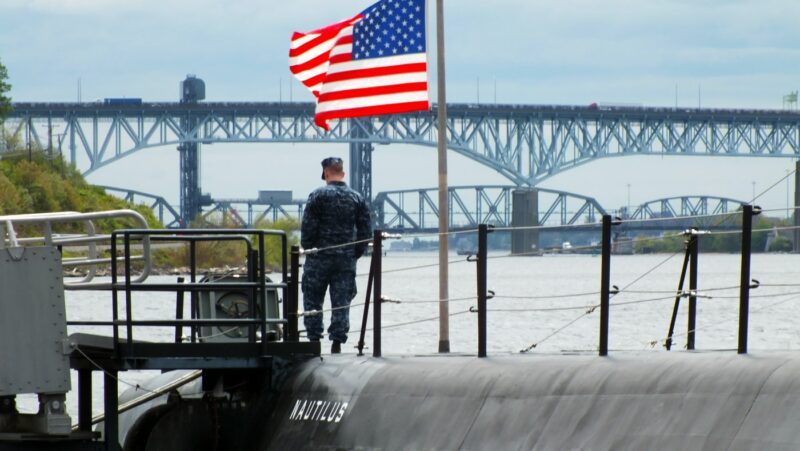Between AUKUS and AUSMIN, Australia has crossed the rubicon
Oct 3, 2021
Through the combination of AUKUS and AUSMIN, Australia has locked in its strategic dependence on the US — probably irreversibly, or in Prime Minister Scott Morrison’s words “forever”.
This is the culmination of a relentless effort in the past decade by successive US administrations and its military establishment to strengthen Australian defence and intelligence reliance on US. Correspondingly, Australian governments of both persuasions have failed to accept how seriously this has eroded our independent strategic capability.
The ANZUS treaty has afforded Australia a substantial degree of strategic protection though it only enshrined automatic “consultation” rather than military assistance:
“The parties will consult together whenever in the opinion of any of them the territorial integrity, political independence or security of any of the parties is threatened in the Pacific.”
But those words engendered a complacency within Australia which, in turn, has distorted Australian strategic thinking for too long. It also dictated that US strategic thinking would weigh heavily on Australia’s own strategic planning.
As the Cold War receded, and especially after 9/11, the US switched its focus to countering terrorism and the role the US planners envisaged for Australia changed. Apart from seeking Australian boots on the ground in the various “coalitions of the willing”, over time the US turned its attention to its serious defence budgetary challenges and the rising strength of China.
What emerged as the “pivot” under President Barack Obama, meant that the US came to concentrate much more on strengthening its arc of containment around China .It saw an important role for Australia to play in closing off the southern section. This was where the US “submarine gap” concept emerged which led to our next generation submarine quest.
Key US think tanks, the Pentagon and especially PACOM (Pacific command) in Hawaii developed a shopping list of Australian options in their periodic force posture reviews (of the overall military disposition, strength, and condition of readiness of a military) which have continued to be pursued relentlessly in the years since.
Basically, the list included: the temporary rotation of 5000 US Marines to Darwin for training, greater and easier transit use of airfields for bombers and large transport aircraft in northern Australia, use of Cocos for large drones, home porting of a nuclear carrier in Stirling.
Negotiation of these options were strung out over several years. Australia did its own defence posture review in 2011. That same year when, largely for domestic political reasons, Prime Minister Julia Gillard invited Obama to Australia, the US forced through agreement on an initially smaller US Marines rotation and on the use of the airfields.
The US also used the visit as leverage on Australia to pass legislation which contained controversial regulations on the control of research in Australian universities to prevent leakage to third party countries.
As drafted originally, the bill would have imposed stricter regulations than those for US universities and proposed prison sentences on vice chancellors of any universities flouting the new rules. In the following years these were covered by legislation and by a joint statement of principles that provided a common vision for advancing the US force posture initiatives in northern Australia which facilitated the movement of US forces into and through Australia and committed Australia to significant defence infrastructure costs.
In following AUSMINs, the US continued pressure for the significant infrastructure upgrading needed to handle the doubling of the Marine deployments from 2500 to 5000 and the airfields to accommodate large aircraft.
Repeated delays by the Australian side in meeting its share reportedly became an item of some contention in several AUSMINs. Pressure also continued for the carrier home porting at Stirling.
During these years the US side also started to push for agreement for their proposed Marine task forces comprising ships, aircraft and 7500 Marines to visit Darwin three to four times a year. A senior Marine general attending a Talisman Sabre joint exercise in North Queensland also floated the idea of a joint Australian Defence Force-US Marine expeditionary force as a rapid deployment force in the Asian region.But little has been heard of it since.
It was in this same period that the leasing of Darwin Port to a Chinese company attracted controversy in Australia and with the US.
With the pivot faltering and the influence and assertiveness of China growing, concerns then began mounting in the US to review its strategic approach to the region.
The late John McCain, from his key role in the Senate, called for a wholesale review similar to the Asia-Pacific one the Congress had successfully ran years earlier on NATO and Europe.
Not surprisingly, this was welcomed by then PACOM which set to work arguing the need for the commitment of substantial additional resources and hardware to counter the growing vulnerability of its forces in the western Pacific to Chinese land-based missiles.
All of which eventually led to the changing of PACOM’s name to INDOPACOM to recognise the importance of the Indian Ocean — its command boundary was the Indo/Pakistan border — and what now is called the Pacific Deterrence Initiative. Key elements of the latter policy are to “stay small and well forward” with bases for longer range missiles and advance storage of materiel, weapons and fuel “and to develop stronger alliance relationships within the region”.
AUSMIN 2020 reflected the changing role for Australia required by the US policy shift including the announcement of a US-funded, commercially-operated strategic military fuel reserve in Darwin.
But, as others in Pearls and Irritations have noted, this year’s AUSMIN went a very significant step further by tucking away in its mass of verbiage Australian commitments to rotational deployment of “all types” of US aircraft, “increased sustainment” (home porting) of US ships and submarines (presumably including nuclear powered) and — the biggest leap — “sustainment … to support “high-end warfighting operations in the region”.
In his media comments after AUSMIN, Peter Dutton went on to summarise the euphemistic wording by specifically mentioning that this included “basing” and weapons storage — which opens another can of worms about whether this might include nuclear warheads!
Taken together with AUKUS and the “forever” submarine debacle it is hard not to see how all of this has now tipped over into a situation in which the future scope for any independent Australian strategic space is but a dream.
The continuing submarine saga, if a vessel ever eventuates given the time lags and rapid obsolescence rate, the commitments made at AUSMIN 2021 and AUKUS to high-end weaponry and systems has nailed our colours tightly to the US mast and accordingly, as pointed out by a number of commentators, significantly elevated our target status should any military confrontation break out between the US and China.
That could likely trigger deeper involvement as the US seeks to harden counter missile and other defences for its Australia-based assets. Which would almost certainly provoke a further cycle of defence and counter defence arms race for which we would be expected to contribute funding but with diminishing control as the technology grew more sophisticated. The eventual costs to the Australian budget could only grow more substantial.
All of the above makes a mockery of Dutton’s assertion that greater interoperability with US forces enhances our strategic independence. Likewise, we need to temper our seemingly increased reliance on the US dominated Five Eyes intelligence system which has proven vulnerable to “policy driven intelligence” — with disastrous results like in Iraq and later Afghanistan.




